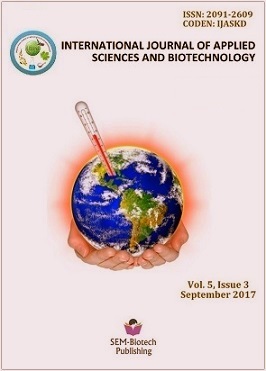Emergence of the Epizootic Ulcerative Syndrome in Pond Reared Carp Fish (Cyprinids) and It's Control Measure in Chitwan, Central Nepal
DOI:
https://doi.org/10.3126/ijasbt.v5i3.18019Keywords:
Cyprinid, EUS, ulceration, granuloma, histology, drugsAbstract
A survey on epizootic ulcerative syndrome (EUS) was carried in carp fish (cyprinids) reared in ponds during January 2016 to January 2017 at six locations of Chitwan, Nepal. Outbreaks of EUS were observed in 39.6% of the carp during winter. EUS infection was the most for Cirrhinus mrigala (47.3% of the 170 samples) and the least for Labeo rohita (12.3% of the 65 samples). EUS infected fish weighing range between 15g-300g were characterized as extensive deep ulceration on head, dorsal and lateral part of body and at caudal peduncle region. Histopathology examination of affected tissue of skin with adjacent muscles showed mycotic granulomas indicated a positive diagnosis for EUS. Survey results indicate that poor water quality in undrained ponds, uncontrolled entry of flooded water into the pond, runoff water from adjacent paddy field and use of contaminated equipment and seine nets were found to trigger risk for EUS infection in carp pond. Impact assessment of EUS showed that average economic loss due to EUS fish disease was 2257.92 kg/ha/year (33.01%) of the expected production. The highest economic loss of 1432.14 kg/ ha/year (53.53%) was estimated for large farm and lowest loss of 950 kg/ha/year (5%) for medium size farm. The simultaneous application of Ciphalexin in feed at 80mg.kg-1 biomass of fish for 15 consecutive days and two applications of Kohrsolin-TH at 900 ml/ha (1 m pond depth water) at weekly interval was found effective to control EUS infection in carps. The combined efficacy of these two drugs was estimated to be 97.7% control of EUS infection in carp fish.
Int. J. Appl. Sci. Biotechnol. Vol 5(3): 313-320




